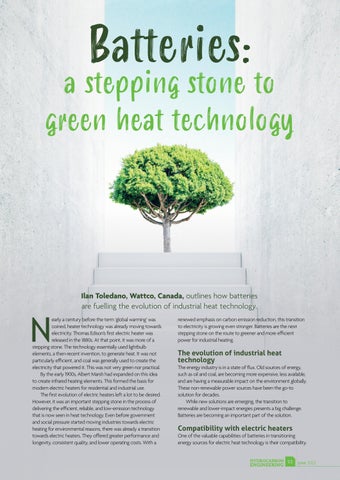N
Ilan Toledano, Wattco, Canada, outlines how batteries are fuelling the evolution of industrial heat technology.
early a century before the term ‘global warming’ was coined, heater technology was already moving towards electricity. Thomas Edison’s first electric heater was released in the 1880s. At that point, it was more of a stepping stone. The technology essentially used lightbulb elements, a then-recent invention, to generate heat. It was not particularly efficient, and coal was generally used to create the electricity that powered it. This was not very green nor practical. By the early 1900s, Albert Marsh had expanded on this idea to create infrared heating elements. This formed the basis for modern electric heaters for residential and industrial use. The first evolution of electric heaters left a lot to be desired. However, it was an important stepping stone in the process of delivering the efficient, reliable, and low-emission technology that is now seen in heat technology. Even before government and social pressure started moving industries towards electric heating for environmental reasons, there was already a transition towards electric heaters. They offered greater performance and longevity, consistent quality, and lower operating costs. With a
renewed emphasis on carbon emission reduction, this transition to electricity is growing even stronger. Batteries are the next stepping stone on the route to greener and more efficient power for industrial heating.
The evolution of industrial heat technology The energy industry is in a state of flux. Old sources of energy, such as oil and coal, are becoming more expensive, less available, and are having a measurable impact on the environment globally. These non-renewable power sources have been the go-to solution for decades. While new solutions are emerging, the transition to renewable and lower-impact energies presents a big challenge. Batteries are becoming an important part of the solution.
Compatibility with electric heaters One of the valuable capabilities of batteries in transitioning energy sources for electric heat technology is their compatibility. HYDROCARBON 53
ENGINEERING
June 2022













